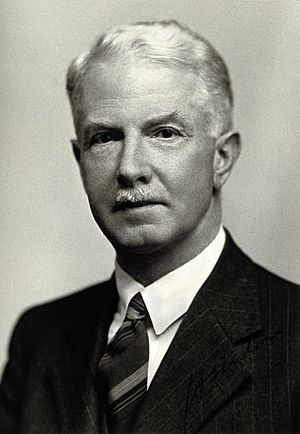John Alexander Sinton facts for kids
Quick facts for kids
John Alexander Sinton
|
|
|---|---|

Portrait. Credit: Wellcome Collection
|
|
| Born | 2 December 1884 Victoria, British Columbia, Canada |
| Died | 25 March 1956 (aged 71) Cookstown, County Tyrone, Northern Ireland |
| Buried |
Claggan Presbyterian Cemetery, Cookstown
|
| Allegiance | United Kingdom |
| Service/ |
British Indian Army |
| Years of service | 1911–1921 1939–1943 |
| Rank | Brigadier |
| Unit | Indian Medical Service |
| Battles/wars | First World War Second World War |
| Awards | Victoria Cross Officer of the Order of the British Empire Mentioned in dispatches (6) Order of St. George, 4th Class (Russia) Fellow of the Royal Society Manson Medal |
| Relations | Thomas Sinton (uncle) James Pringle (cousin) Ernest Walton (cousin) |
| Other work | Malariologist |
Brigadier John Alexander Sinton (born December 2, 1884 – died March 25, 1956) was a brave British medical doctor and soldier. He was also a malariologist, which means he studied and fought against malaria, a serious disease spread by mosquitoes.
Sinton received the Victoria Cross (VC), which is the highest award for bravery in the face of the enemy for British and Commonwealth forces. He was also honored with the Officer of the Order of the British Empire (OBE) and became a Fellow of the Royal Society (FRS), a group of top scientists.
Early Life and Education
John Alexander Sinton was born in Victoria, British Columbia, Canada. He was one of seven children. His family were Quaker linen manufacturers from Ireland. In 1890, when he was six years old, his family moved back to Ulster, Ireland. He lived there for the rest of his life.
John went to the Royal Belfast Academical Institution. He then studied medicine at the Queen's University, Belfast. He was very good at his studies, graduating first in his class in 1908. He continued his education, earning more degrees from the University of Cambridge in 1910 and the University of Liverpool in 1911.
In 1911, Sinton joined the Indian Medical Service (IMS). This was a medical branch of the British Indian Army. He came first in the entrance exams, showing how smart he was. Before going to India, he worked at the Liverpool School of Tropical Medicine. Here, he met Sir Ronald Ross, a famous scientist who discovered how malaria spreads. This meeting likely inspired Sinton's future work on malaria.
Military Bravery
During the First World War, John Sinton was a Captain in the Indian Medical Service. He was 31 years old when he showed incredible bravery. On January 21, 1916, at a place called Orah Ruins in Mesopotamia (which is now Iraq), Captain Sinton helped wounded soldiers. This was happening under very heavy enemy fire.
His award citation for the Victoria Cross explains his actions:
For most conspicuous bravery and devotion to duty. Although shot through both arms and through the side, he refused to go to hospital, and remained as long as daylight lasted, attending to his duties under very heavy fire. In three previous actions Captain Sinton displayed the utmost bravery.
This means that even though he was shot three times, he kept helping others. He stayed on duty all day, despite the danger. He had also shown great courage in three battles before this one.
Sinton later reached the rank of brigadier in 1943. He also received the Russian Order of St George. He was mentioned in official reports six times for his brave actions. In 1921, he moved from the military side of the IMS to the civilian side, continuing his medical work.
Fighting Malaria
In July 1921, John Sinton took charge of a special project. This project looked into quinine, a medicine for malaria, and the disease itself. He became the first director of the malaria survey of India in 1925. He worked with Sir S. R. Christophers to study and fight malaria.
Later, he became an expert on malaria for the Ministry of Health. When the Second World War began, Sinton was called back to serve in the IMS. He commanded a hospital in India. Even though he was 55, he continued to serve. He then became a consultant (an expert advisor) on malaria for forces in East Africa and the Middle East. He retired with the honorary rank of brigadier in August 1943.
After retiring, he continued to work as a malaria expert for the War Office. He traveled to many places like Assam, Australia, Burma, Ceylon, India, New Guinea, and the Solomon Islands. His knowledge about malaria was very important in these areas. After this, Sinton returned to Northern Ireland and settled in Cookstown. In 1946, he was elected a Fellow of the Royal Society, a great honor for scientists.
Legacy and Recognition
John Sinton is the only Fellow of the Royal Society to have also received a Victoria Cross. This shows his amazing achievements in both science and military service. In his retirement, he served as Deputy Lieutenant for County Tyrone. In 1953, he was the High Sheriff of Tyrone.
He married Eadith Seymour Steuart-Martin in 1923. Their daughter, Eleanor, was born in 1924.
Sinton's name is remembered in several ways. Sinton Halls, a student building at the Queen's University, Belfast, is named after him. He was also a Pro-Chancellor at the university. The Sinton Medical and Dental Centre at Thiepval Barracks in Lisburn also honors him. Scientists even named three mosquito species and one sandfly species after him, recognizing his important work in fighting malaria.
John Sinton passed away at his home in Cookstown on March 25, 1956. He was buried with full military honors. A fellow doctor, Colonel H. W. Mulligan, described him as having a very quick and smart brain. He also said Sinton's greatness came from his honesty and hard work.
His Victoria Cross medal is on display at the Army Medical Services Museum in Aldershot.


